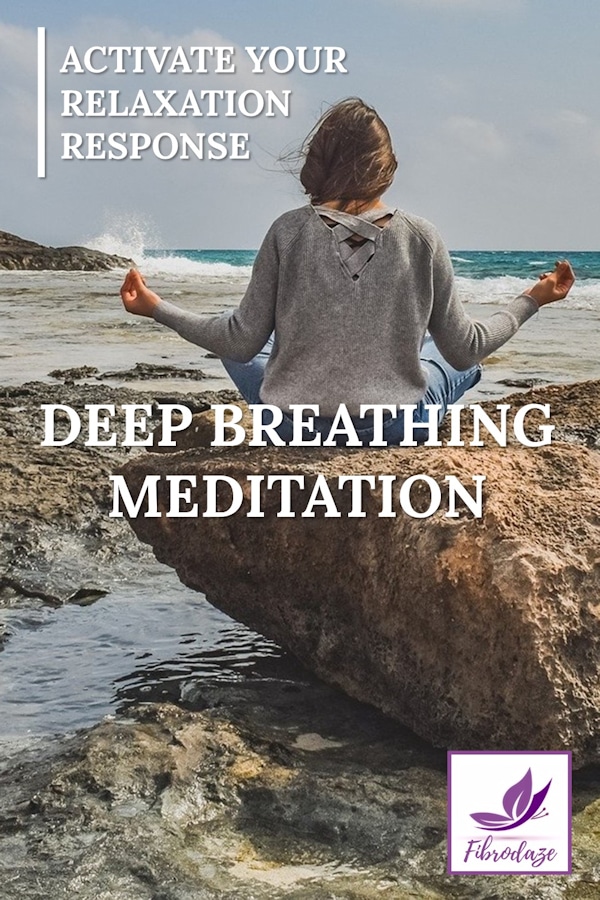Deep breathing meditation is a simple yet powerful relaxation technique. It is easy to learn and can be practiced almost anywhere. It has been shown to have benefits in treating conditions ranging from migraines and irritable bowel syndrome to anxiety disorders and chronic pain.

Deep breathing is the cornerstone of many other relaxation techniques because it arouses a relaxation response from the body which counteracts the stress (fight or flight) response.
People with fibromyalgia tend to breathe too fast taking short shallow breaths. This type of breathing increases the feeling of tension and anxiety that can make fibromyalgia symptoms worse. In addition, we tend to get short of breath easily.
Even if you feel mentally calm, if your breathing rate is overly fast, this causes fight or flight response activation. Focusing on your deep, rhythmic breathing shifts the body out of the fight or flight mode and into the relaxation response.
Benefits Of Deep Breathing Meditation
Meditation is the art of focusing 100 percent of your attention to one area. In this case, your breathing. There is a growing appreciation for the positive impact that deep breathing meditation can have on, both the mind and the body. The Harvard Medical School Family Health Guide have pages devoted to the subject of deep breathing and its health benefits.
A regular daily practice of deep breathing meditation is one of the best tools for improving your overall health and well-being. The health benefits include:
- Respiratory difficulties such as asthma can improve
- Digestion system improves
- Reduces feelings of stress, anxiety, and depression
- Lowers/stabilizes blood pressure
- Increases energy levels
- Reduces pain and muscle tension
- Improves sleep
- Improves concentration, problem-solving and learning skills
You can use deep breathing meditation anytime you are feeling stressed or notice that your breathing has become constricted. Deep breathing can be combined with other relaxing elements such as aromatherapy and music to enhance the benefits.
Practicing Deep Breathing Meditation
The key to deep breathing is to breathe deeply from the abdomen, getting as much air as possible into your lungs. When you take deep breaths from your abdomen instead of shallow breaths from your upper chest, you inhale more oxygen. The more oxygen you inhale, the less tense, short of breath and anxious you feel.
- Sit comfortably with your back straight. Put one hand on your chest and the other on your abdomen.
- Breathe in through your nose. The hand on your stomach should rise. The hand on your chest should move very little.
- Exhale through your mouth, pushing out as much air as you can while contracting your stomach. The hand on your stomach should move in as you exhale. The hand on your chest should move very little.
- Continue to breathe in through your nose and out through your mouth. Try to inhale enough so that your lower abdomen rises and falls.
If you find it difficult breathing from your abdomen while sitting up, try lying down. Put a small book on your stomach and try to breathe so that the book rises as you inhale and falls as you exhale.
Deep Breathing Meditation With Visualization
This relaxation exercise utilizes visualization and deep breathing. They are a powerful combination to stop an acute stress response in its tracks. All you need is a few minutes and a quiet place to stretch out.
- Lie down on the floor. To begin, close your eyes and relax. Visualize a balloon that has not been blown up. Now imagine that you are blowing up the balloon by slowly pumping air into it. When it feels like the balloon is full of air, take a big deep breath. Hold it for several seconds and then let it out very slowly. Repeat this a few times.
- Now scrunch up your toes as tight as you can and slowly count to 10. On the count of 10, take a big, deep breath and slowly let your toes relax.
- Now visualize a rubber band. Pretend your legs are a huge rubber band and that you are going to stretch that rubber band (your legs) as tight as you can. Hold your legs still and slowly count to 10. On the count of 10, take a deep breath and pretend that you are letting go of the rubber band so that all the tension is gone.
- Next, visualize a piece of elastic and imagine stretching it tight. Pretend your arms are like the elastic. Stretch them and hold them very tight. Slowly count to 10. When you reach 10, take a deep breath and imagine letting go of the elastic so that it snaps back to a relaxed state.
- Finally, visualize a rubber ball and imagine that you are clenching it in one of your hands. As you hold your breath, squeeze the ball tightly and count to 10. At the count of 10, release the ball as you breathe out slowly. Repeat this using the other hand.
There is also a wearable device called Spire. The device helps people become more aware of their own breathing patterns and know when to slow down and take a deep breath. Spire includes an app which leads users through a series of brief deep breathing exercises.
Bottom Line
Our breathing rate is a key regulator of the balance between the sympathetic nervous system (fight or flight response) and parasympathetic nervous system (relaxation response). Deep breathing meditation arouses a relaxation response from the body which counteracts the stress response.
Regular daily practice of deep breathing meditation can help you enjoy a better quality of life, especially if you have an illness that is exacerbated by stress. In fibromyalgia, deep breathing meditation has been proven to reduce anxiety and depression, reduce the duration of migraine headaches and decrease other symptoms including pain. With regular practice, you will begin to breathe more effectively overall, even without thinking about it.
Do you practice deep breathing meditation? If so, how has it helped your fibromyalgia symptoms?
Pin for Later






Thank you for the valuable information this article gives us. It is very important to learn breathing techniques to maintain our physical and mental balance
Your welcome.